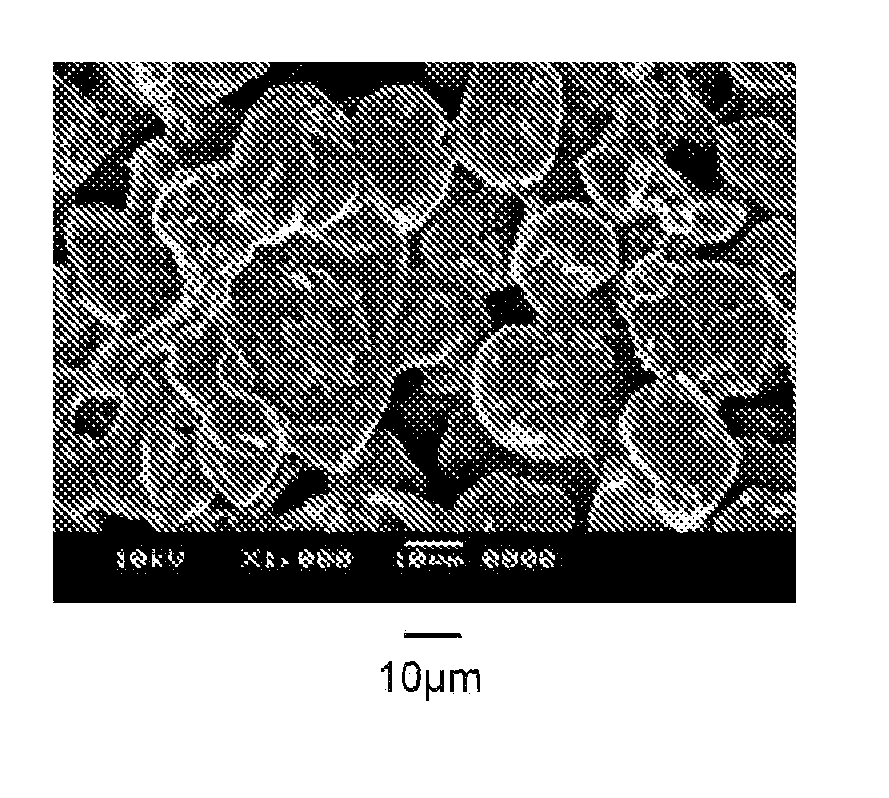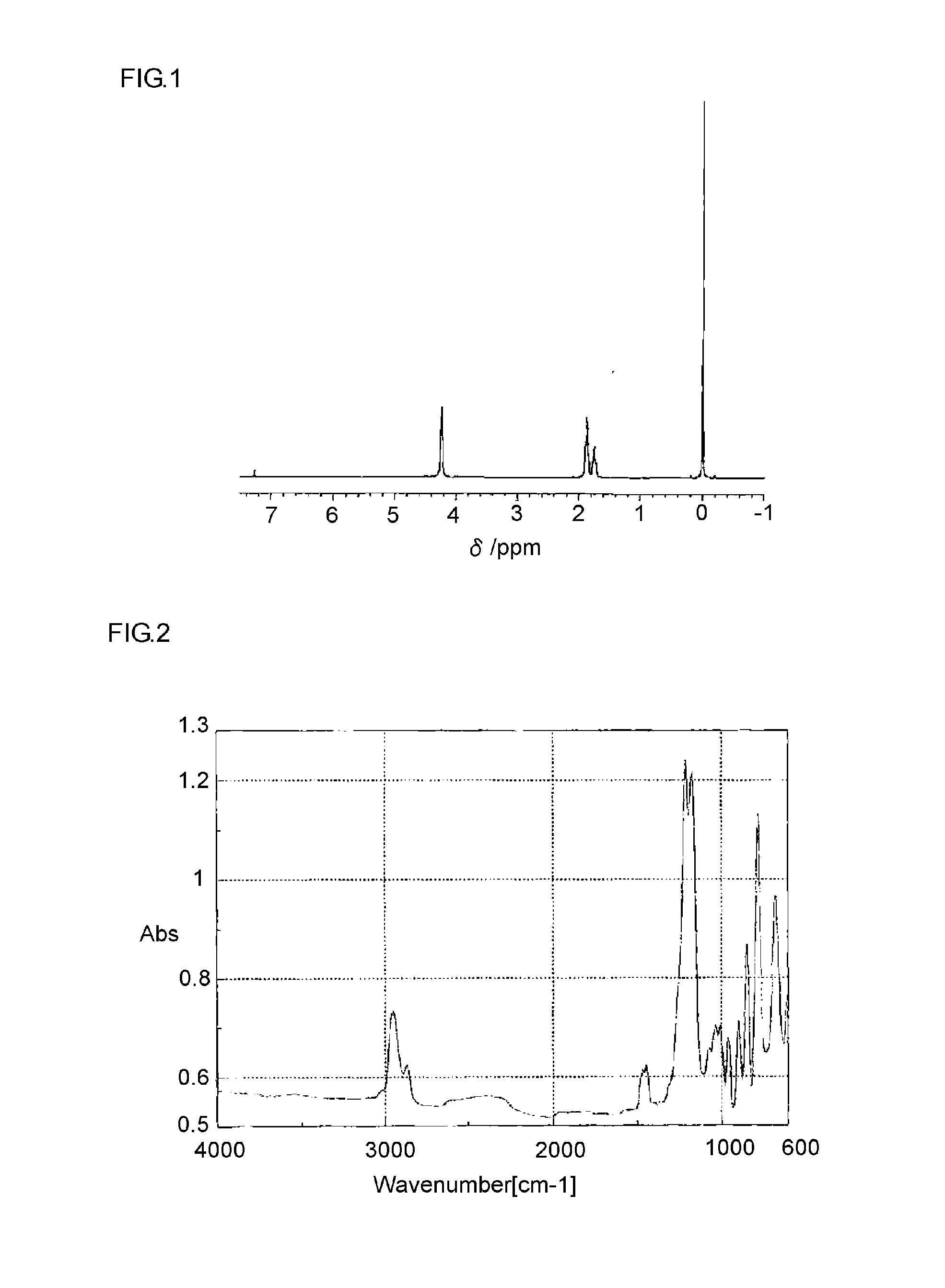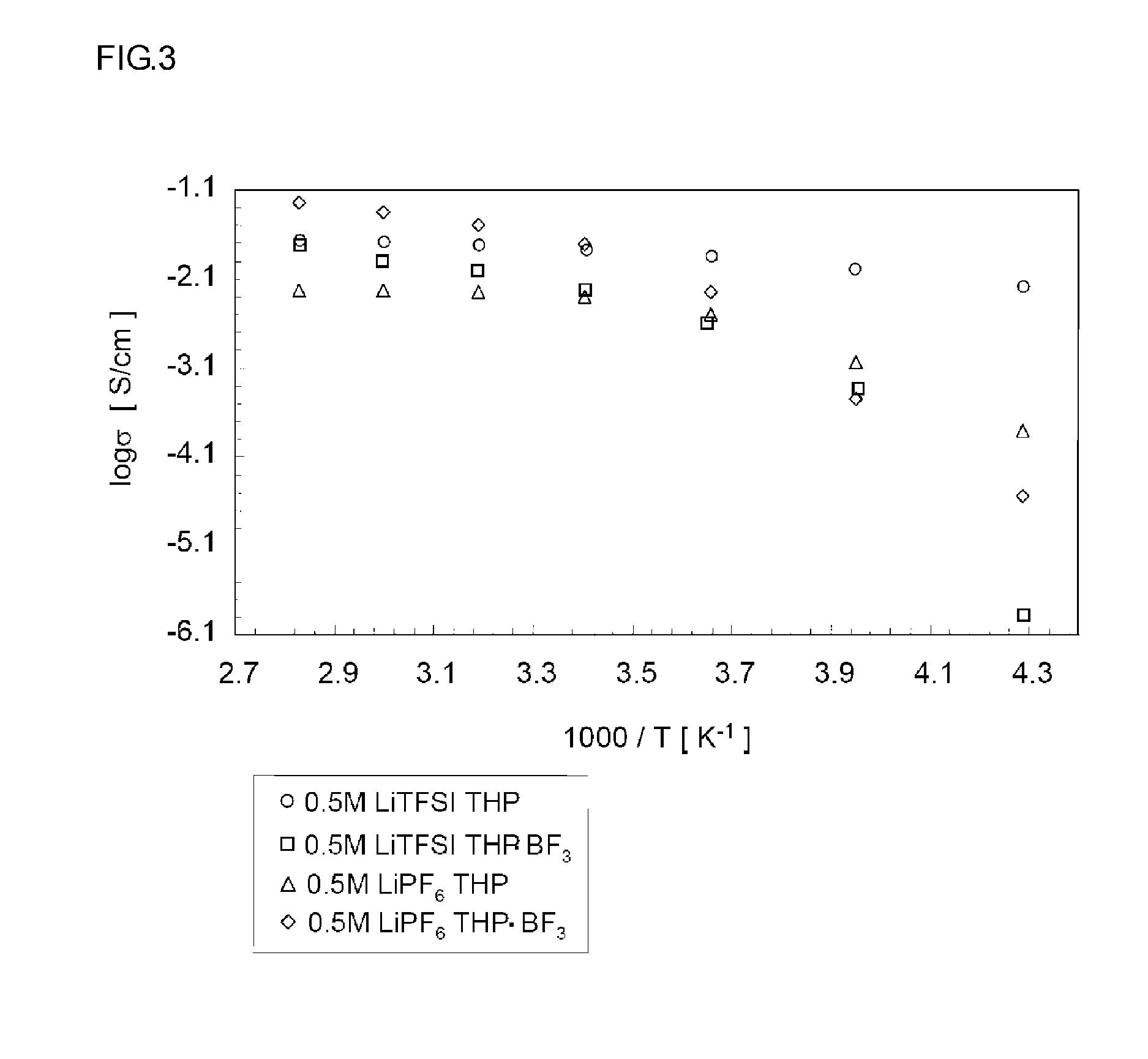Electrolyte solution and use therefor
a technology of electrolyte solution and electrolyte, which is applied in the direction of non-aqueous electrolyte cells, sustainable manufacturing/processing, secondary cell details, etc., can solve the problems of reducing the durability of lithium ion batteries, reducing the capacity, and damage, so as to achieve easy to obtain or synthesize, high oxidation resistance, and reduced damage
- Summary
- Abstract
- Description
- Claims
- Application Information
AI Technical Summary
Benefits of technology
Problems solved by technology
Method used
Image
Examples
example 1
Electrolyte Solutions Using BF3-THP Complex as Solvent
[0053]3.00 g of tetrahydropyran (THP) and 3.95 g of BF3-diethyl ether complex were placed in a reaction container, and stirred for 3 days at 45° C. in a flow of nitrogen gas to perform an ether exchange reaction. This was distilled twice under reduced pressure to obtain 3.21 g of BF3-THP complex as a colorless liquid.
[0054]The resulting BF3-THP complex was subjected to 1H-NMR and 13C-NMR measurement, and synthesis of the target BF3-THP complex was confirmed based on these NMR spectra. The melting point of the BF3-THP complex was −18.2° C. The spectrum data are given below. The results of 1H-NMR are also shown in FIG. 1. The results of IR measurement are shown in FIG. 2.
[0055][C7]
BF3-THP
[0056]1H-NMR (CDCl3): 4.2 ppm (OCH2CH2CH2), 1.85 ppm (OCH2CH2CH2),[0057]1.73 ppm (OCH2CH2CH2)
[0058]13C-NMR (CDCl3): 73.3 ppm (OCH2CH2CH2), 24.7 ppm (OCH2CH2CH2),[0059]21.5 ppm (OCH2CH2CH2)
[0060]LiPF6 was added to the complex obtained above in a glo...
example 2
Electrolyte Solutions Using BF3-THF Complex as Solvent
[0061]A commercial boron trifluoride-tetrahydrofuran (BF3-THF) complex was distilled under reduced pressure, processed with metal lithium and purified by rectification. LiPF6 was added to the purified BF3-THF complex (melting point—3.7° C.) in a glove box in argon atmosphere, and mixed with stirring for 24 hours to prepare an electrolyte solution comprising 0.1 mol / kg of LiPF6 dissolved in the BF3-THF complex. An electrolyte solution comprising 0.1 mol / kg of LiBF4 dissolved in the BF3-THF complex was prepared in the same way. Electrolyte solutions comprising LiTFSI dissolved in the BF3-THF complex at concentrations of 0.1 mol / kg, 0.5 mol / kg, 1.0 mol / kg and 2.0 mol / kg were also prepared in the same way.
example 3
Electrolyte Solution Using BF3-2MeTHF Complex as Solvent
[0062]5.9 g of 2-methyltetrahydrofuran (2MeTHF) and 10.0 g of BF3-diethyl ether complex were placed in a reaction container, and stirred for 2 days at 40° C. in a flow of nitrogen gas to perform an ether exchange reaction. This was then distilled under reduced pressure, processed with metal lithium and rectified to obtain 4.6 g of BF3-2MeTHF complex as a colorless liquid.
[0063]The 1H-NMR and 13C-NMR spectra of the resulting BF3-2MeTHF complex were measured, and synthesis of the target BF3-2MeTHF complex was confirmed from the results. The melting point of this BF3-2MeTHF complex was −37.5° C. The spectrum data are shown below.
[0064][C8]
BF3-2MeTHF
[0065]1H-NMR(CDCl3): 4.9 ppm (s:OCHCH3), 4.3 ppm (d:CH2OCHCH3),[0066]2.4 ppm (q:OCHCH3CHH),[0067]2.2 ppm (q:OCHCH3CH2CH2),[0068]1.8 ppm (q:OCH2CH3CHH), 1.48 ppm(d:CH2OCHCH3)
[0069]13C-NMR(CDCl3): 84.1 ppm (OCH2CH3C), 72.6 ppm (COCHCH3),[0070]32.9 ppm (OCHCH3C), 24.3 ppm (OCHCH3CC),[0071]...
PUM
| Property | Measurement | Unit |
|---|---|---|
| temperature | aaaaa | aaaaa |
| boiling point | aaaaa | aaaaa |
| temperature | aaaaa | aaaaa |
Abstract
Description
Claims
Application Information
 Login to View More
Login to View More - R&D
- Intellectual Property
- Life Sciences
- Materials
- Tech Scout
- Unparalleled Data Quality
- Higher Quality Content
- 60% Fewer Hallucinations
Browse by: Latest US Patents, China's latest patents, Technical Efficacy Thesaurus, Application Domain, Technology Topic, Popular Technical Reports.
© 2025 PatSnap. All rights reserved.Legal|Privacy policy|Modern Slavery Act Transparency Statement|Sitemap|About US| Contact US: help@patsnap.com



